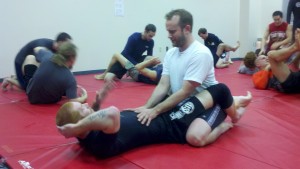 Have you ever played solitaire on your computer? Ever notice that you don’t really scan every individual combination of cards when you are presented with a new set of three cards? Instead, you tend to hover the mouse over the deck, ready to click to the next set of three cards very rapidly. You are able to do this because you are able to generalize: red cards must be paired with black cards, so that limits a certain percent of the possible moves; the next number up from any card is of desired interest.
Have you ever played solitaire on your computer? Ever notice that you don’t really scan every individual combination of cards when you are presented with a new set of three cards? Instead, you tend to hover the mouse over the deck, ready to click to the next set of three cards very rapidly. You are able to do this because you are able to generalize: red cards must be paired with black cards, so that limits a certain percent of the possible moves; the next number up from any card is of desired interest.
The same thing happens in jiu jitsu: you tend to make broad generalizations about similar situations, and that helps you recognize patterns. One simple example of this is when you first start training jiu jitsu, you will typically tend to try and memorize things you’re not supposed to do in certain situations. Quite frequently, this is called posture. One obvious example is that you don’t normally ever want to try to go for an Americana while inside the other person’s guard, especially their closed guard. Another might be that you don’t ever want to have your hands on the mat. Both of these are pretty specific in nature- things not to do while rolling- but if you are able to lump them together into a broader category of what to do- hands go in a specific region of the person’s torso while in the guard, elbows stay in- you can start to make progress toward a deeper understanding of the underlying principle of the position, not just memorization.
It will eventually click (if you keep doing BJJ for long enough) that you have to keep your elbows in close to your body (generally speaking) whenever you are in a dangerous position.
An even broader example of this might be the simple but elusive concept of base. Taking away a person’s base allows you to sweep them easily, but at first, you must learn a specific set of sweeps that work. Just as you have to learn the rules of any game you play by first examining the way specific actions happen (moves in chess, plays in a team sport, or techniques in BJJ), you must first learn a select handful of specific sweeps. If you sit up into your partner and find them to be leaning backward, you can execute an easy hip sweep (hip bump sweep, as it is sometimes called). If they defend that, you might find that a Kimura (shoulder lock) from that position makes more sense because they’re forced to base. If they drive back into you from there, you might find that a guillotine choke works best. All three of these positions are from “armpit on shoulder” position from closed guard, and there are hundreds of other positions like this, from which there are multiple high percentage attacks.
In every one of these techniques lies a fundamental concept you can discover. If you start thinking deeply about it now, you might make these discoveries sooner rather than later.